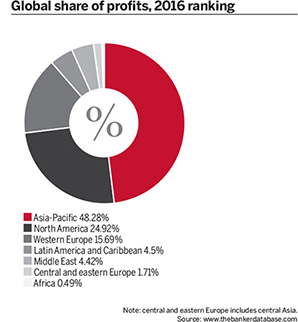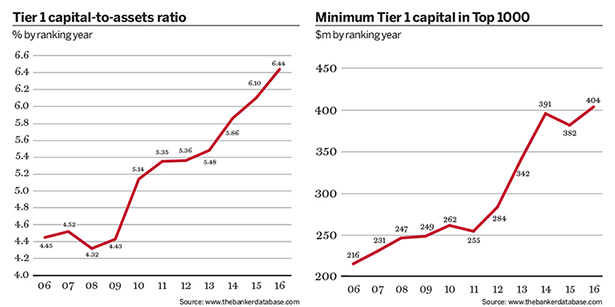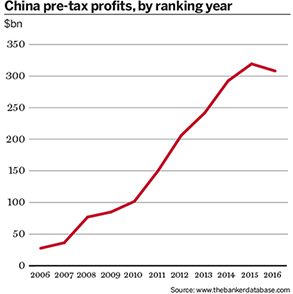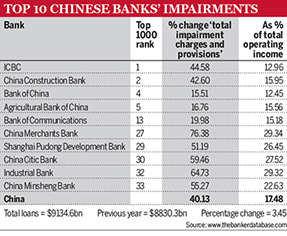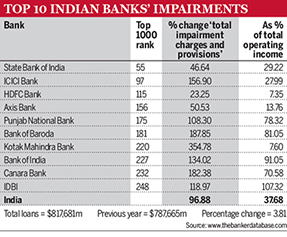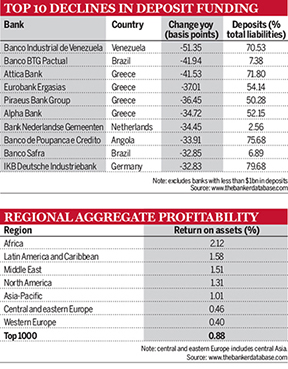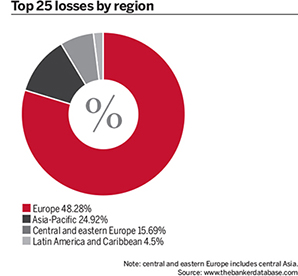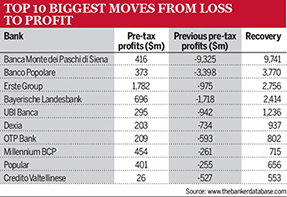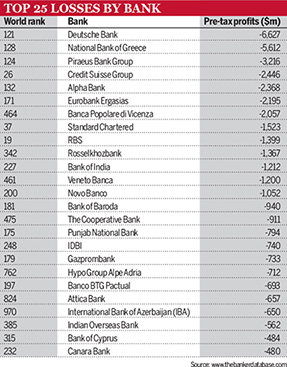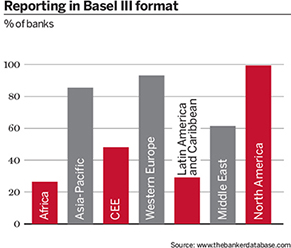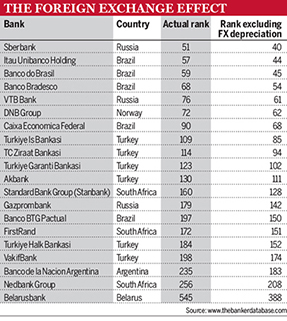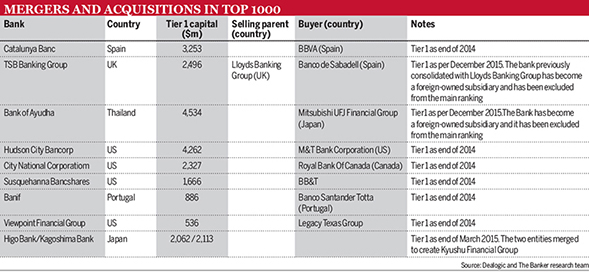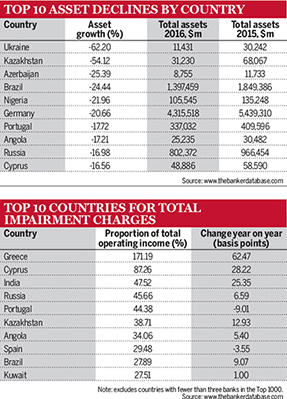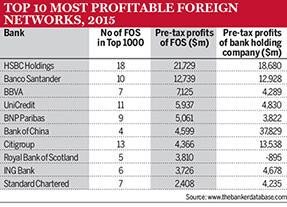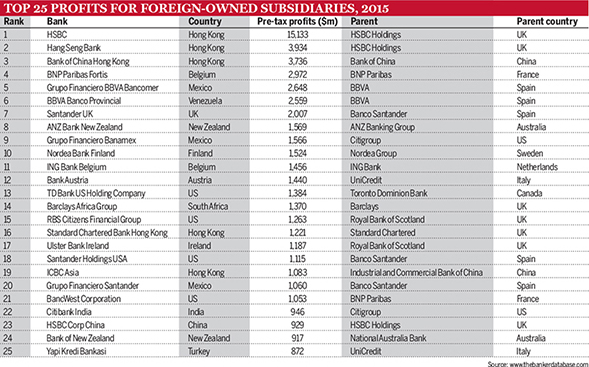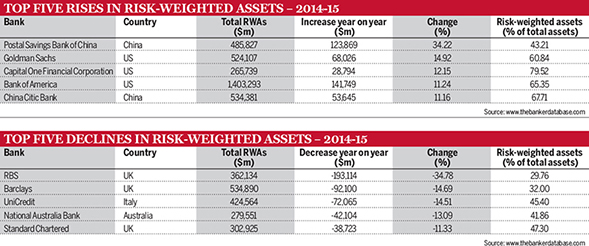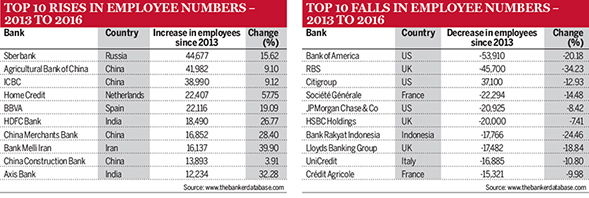The year 2015 was not kind to the global banking industry. It began with a nasty shock when the Swiss National Bank (SNB) depegged the Swiss franc on January 15, causing mayhem in the markets.
Not only were hundreds of millions of dollars wiped off banks’ trading desks – businesses already under pressure from reduced margins, challenging market conditions and misconduct fines – but thousands of Polish and Hungarian mortgages priced in the Swiss currency were affected. More ominously, the SNB’s actions shattered the comforting belief that central banks are a benevolent force in the global financial system.
In March the European Central Bank (ECB) announced a €1100bn quantitative easing (QE) programme to run until September 2016 (recently increased from €60bn to €80bn a month and extended into 2017). QE did not have the desired effect of encouraging eurozone banks to lend more money, because they still held an estimated €1000bn of bad loans on their balance sheets at the end of 2015.
In addition, the ECB’s adherence to negative interest rates throughout 2015 – implementing another cut in December – has eroded European banks’ earnings.
The US Federal Reserve, on the other hand, decided in mid-December to make its first rate increase since 2006 – a modest rise of 0.25%. As most banks’ fiscal year ends in December, the hike itself had little impact on the Top 1000 World Banks results in 2016; however the uncertainty and concern over a Fed rate hike haunted markets throughout the year.
Similarly, the spectre of a possible ‘Brexit’ worried global markets throughout the second half of 2015. With a majority in the UK voting to leave the EU, the referendum’s result is sure to have a significant effect on next year’s Top 1000 World Banks rankings.
Over in China
The system shocks were not limited to the west. In August, China rattled the global markets by devaluing the yuan. The central bank cut its daily reference rate by 1.9%, triggering the yuan’s biggest one-day drop since 1993, according to the Financial Times. Emerging markets tumbled, with Kazakhstan dropping its currency peg altogether.
In addition, the moribund macroeconomic environment compounded the global banking industry’s misery. According to the International Monetary Fund’s World Economic Outlook April 2016 report, global growth in 2015 remained sluggish at 3.1%, as emerging markets continued to decelerate. Commodity prices fell, particularly oil, which plunged by 47%. In addition, the strong US dollar played havoc with many currency exchange rates – an issue we explore in greater detail later in the introduction.
It comes as no surprise, therefore, that the aggregate total assets of the Top 1000 World Banks have decreased in the 2016 rankings – although perhaps some expected a greater drop than 2.6%. Profits dropped by 1.8%, compared with a 7.8% increase in the 2015 results.
Aggregate Tier 1 capital, on the other hand, experienced a slight increase, to $7101bn, indicative of more banks fulfilling Basel III requirements. The Tier 1 capital-to-assets ratio has also increased a little, as banks continue to increase their capitalisation.
The threshold to enter the Top 1000 has exceeded $400m for the first time, doubling the minimum amount needed in 2005 to join the elite club.
Global share of profits
For the first time since 2012, the Asia-Pacific region has not generated the majority of global profits. The region’s share has fallen to 48.3% in the 2016 rankings.
North America, the Middle East, Africa and western Europe have all slightly expanded their share of profits. Central and eastern Europe’s (CEE’s) portion shrank by more than half and Latin America and the Caribbean’s share also fell, mainly as a result of a strong US dollar and deteriorating domestic economic and political conditions in many countries.
China has remained the largest single banking market by Tier 1 capital for the second year in a row, increasing its aggregate Tier 1 by 12.4%; in addition its asset base expanded by 8.4%. The US has taken second place, with Tier 1 capital increasing by 4.6%, compared with a 0.5% rise in assets.
While the eurozone has remained in third place, it continues to lose ground to the leaders. Overall the region saw a 3.6% reduction in Tier 1 capital and a 9.1% drop in assets. However, its pre-tax profits went up by 53.3%. Japan also added to aggregate Tier 1 capital, increased assets and nearly doubled its pre-tax profits.
China’s profit rate wanes
For the first time following a decade of spectacular growth, the aggregate profits of Chinese banks in the 2016 rankings have not increased. Pre-tax profits fell by 3.5%, to $308bn, compared with the 2015 rankings.
Despite this small contraction in profits, in general the Chinese banking sector has continued its upward trajectory. Tier 1 capital grew by 12.4% at an aggregate level, higher than many countries in the region, while total assets increased by 8.4%. It is important to note that there are no loss-making Chinese banks in the 2016 ranking.
Chinese banks now occupy four of the top five places in the Top 1000 World Banks. Agricultural Bank of China has moved up one spot to push Bank of America Merrill Lynch into sixth place, leaving JPMorgan as the only non-Chinese bank in the top five. The country has also added two banks to its ranks in the top 1000 compared with the 2015 rankings, bringing its total number to 119.
The decline in profitability was fairly universal, with the big four banks – ICBC, China Construction Bank, Bank of China and Agricultural Bank of China – seeing drops between 5% and 6%.
A worrying sign is the more than 40% rise in impairment provisions across the top 10 Chinese banks included in the 2016 results. Nonetheless, some analysts believe that reported impairments are nowhere near true levels. In general, increases are smaller at the larger banks, for example 15.5% at the Bank of China and 16.8% at the Agricultural Bank of China; and larger at the mid-sized banks, such as 188% at Huishang Bank and 172.9% at Bank of Jingzhou, ranked 25th and 38th in the country, respectively. ICBC, which posted a 44.6% increase in total impairment charges, is an exception to this rule.
Similarly, non-performing loans (NPLs), which are loans more than 90 days past due, also increased in China but not at the rate expected. For example, Bank of China posted a 0.25 percentage point increase, bringing it up to 1.43%, while Agricultural Bank of China showed a 0.85 percentage point increase to 2.39%.
Many Chinese banks use a category called ‘special mention loans’, which the Hong Kong Monetary Authority defines as: “Loans with which borrowers are experiencing difficulties and which may threaten the authorised institution’s position.” These are not included in the NPL measure but reported separately, which clouds the true picture around stressed assets.
India’s rising debt
Bad debt is also affecting the Indian banking sector. India is third in the top 10 countries for total impairment charges as a share of total operating income, behind Greece and Cyprus. Total impairments charges and provisions have risen by 96.9% year on year for the top 10 Indian banks in the 2016 rankings.
This is a growing concern, as India does not have the same profit cushion as China. Several of the large banks reported losses in 2015, including Punjab National Bank, Bank of Baroda, Bank of India, Canara Bank and IDBI Bank.
At each of these banks, ballooning impairment loans and charges grew by more than 100%, eating into their profits. However, this trend is not limited to loss-making banks. Kotak Mahindra Bank and Federal Bank are both still profitable, despite posting 354.8% and 532.5% provision increases, respectively.
The rise in NPLs is not as dramatic, although there is an upward trend. Some of the largest increases have occurred at Bank of India and Canara Bank, both state-owned. Among the top 10 Indian banks by Tier 1 capital, state-owned banks exhibit the six highest NPL ratios.
However, more pain is expected well into 2016 following the Reserve Bank of India’s (RBI’s) audit. In December, RBI governor Raghuram Rajan set lenders a March 2017 deadline to clean up their balance sheets; however, his departure, planned for September, leaves a question mark over whether his successor will carry out the plan with the same vigour.
Despite the problems with NPLs, Indian banks still managed to build up capital and total assets. Aggregate Tier 1 capital in the country rose 9.1% in 2015, with the largest capital increases coming from IndusInd Bank and Kotak Mahindra Bank.
There is now one more Indian bank in the ranking, IDFC Bank, which has entered in 427th place, after it was created in October 2015 as a part of IDFC, an infrastructure company.
Japan’s changing fortunes
Japan has improved its overall positioning in the 2016 results, adding a third bank to the top 20 in the global ranking. Mizuho Financial Group has moved up three places to 18th, while Sumitomo Mitsui Financial Group has moved up four spots to 15th, mainly at the expense of European banks.
The country performed well in terms of steady capital and asset growth, but not in profitability. Aggregate Tier 1 capital growth was 13%, which is high for the region, and asset growth was 10.8%, which is also high. These improvements are largely because the yen was one of the few currencies to increase against the dollar in 2015. Profits on the other hand dropped by 5.1%.
All but 12 of the 90 Japanese banks in the Top 1000 posted increases in Tier 1 capital. Shinkin Central Bank saw the largest increase in the country (28.4%).
Persistent doldrums in Europe
Europe as a whole seemed to lurch from one crisis to another in 2015, with a profound effect on the banking sector. Banks had to cope with low or negative interest rates, regulatory uncertainty and increasing debt levels.
At the aggregate level, western Europe lost 5.1% of Tier 1 capital and 12.7% of aggregate assets. However, at the same time it managed to increase profitability by 8.4%.
Eurozone countries were hit by the depreciating euro, which saw a more than 10% drop in 2015. This resulted in a decline in Tier 1 capital and total assets, with Germany and Cyprus posting the largest declines in Tier 1 capital, of 22.7% and 16.8%, respectively. The most dramatic aggregate falls in assets were 20.7% in Germany and 17.7% in Portugal.
All but one of the 10 biggest loss-making banks in the Top 1000 2016 rankings are based in western Europe, with the exception of Russian Rosselkhozbank. Unsurprisingly, Greek banks are among the top loss-makers, including National Bank of Greece, Piraeus Bank Group, Alpha Bank and Eurobank Ergasias.
However, it was a German institution – Deutsche Bank – that posted the biggest loss in 2015 of $6.6bn, its first annual loss since the 2008 crisis.
Last year was truly an annus horribilis for the German lender. Co-CEOs Anshu Jain and Juergen Fitschen left the bank in mid-2015, just weeks after it was hit with a record $2.5bn Libor penalty. In October, new CEO John Cryan announced an extensive restructuring plan, including selling the German retail arm Postbank, halving client numbers in global markets and corporate and investment banking, withdrawing from 10 countries and eliminating more than 15,000 positions.
Deutsche Bank’s weight within the German banking system – constituting 34.5% of Tier 1 capital out of the 21 German banks in the Top 1000 – meant that Germany has featured in the top 10 in asset declines by country, alongside the likes of Ukraine, Brazil and Nigeria.
However, despite Germany’s poor performance, overall the eurozone improved its profitability. France contributed a 30.5% growth in pre-tax profits, which can be attributed to BNP Paribas’ good results. Belgium provided another boost, 21.7%, thanks to Dexia’s return to profitability.
British blues
The UK banking sector suffered in 2015, afflicted by high misconduct fines for payment protection insurance (PPI) mis-selling and foreign exchange market rigging.
At the aggregate level, UK banks’ Tier 1 capital dropped slightly, total assets fell by 14.6% and pre-tax profits by 22.1%. This can be attributed to falling profits at the largest banks: -19.3% at Barclays, -56.2% at RBS and -10.7% at Lloyds.
Additionally, Standard Chartered moved into the red for the first time since 1989, with a $1.52bn loss, as revenue fell and loan impairments more than doubled to the highest in its history. HSBC, on the other hand, posted a 1% rise in profits.
Surprisingly, both Standard Chartered and HSBC decided to remain headquartered in the UK. The former’s main reason was attributed to the UK Treasury’s decision to cut back the bank levy, while after a 10-month review HSBC cited the country’s regulatory framework and international experience among its reasons for staying. However, the UK referendum vote in favour of leaving the EU may cast a shadow over those conclusions.
There are strong headwinds ahead. In October, the Bank of England (BoE) published further proposals on ring-fencing banks’ core retail activities, in order to easily separate these entities from their groups in the event of failure, from January 1, 2019. Banks will also have to set aside a special capital buffer – called the ‘systemic risk buffer’ – of up to 3% of their assets.
The six biggest banks – those with core deposits exceeding $35bn – will be the most likely affected by the new regulations and may be required to hold up to $4.7bn of extra capital, experts predict.
Greek woes linger on
While all Greek banks in the Top 1000 2016 ranking posted losses in 2015, annual results show that NPL growth has slowed at Greece’s four biggest banks. Additionally, all four expanded their capital cushions and reduced their dependence on the Eurosystem funding mechanism.
Three of the four largest Greek banks – Eurobank, Alpha Bank and National Bank of Greece (NBG) – ended 2015 with greater losses than in 2014. The fourth, Piraeus, showed a slight improvement (€84m) compared with the previous year, but this can be attributed to a difficult 2014 when it ended the year with €3bn in losses, far more than the other three.
In November 2015, the ECB conducted stress tests, which uncovered a capital gap of €14.4bn for these lenders. The capital raising that followed considerably improved their capital positions. Now, the largest Greek lenders can rely on core equity Tier 1 (CET1) capital of about 17%.
Problems persist in CEE
While western Europe has performed disappointingly in the 2016 Top 1000 rankings, the situation was worse in CEE, where Tier 1 capital dropped by 13.6%, total assets by 16.6% and profits by 40%.
Hungary fared poorly, hit by a falling currency. The forint dropped by 9.6% in 2015, while Tier 1 capital dropped by 6%, aggregate assets by 3.7% and profits by 49.8%. Capitalisation took a hit at two largest local banks, OTP Bank and Budapest Bank, which dropped by 17% and 7.8%, respectively.
Ukraine reported a 67.4% plunge in aggregate Tier 1 capital, dropping from three banks to one in the Top 1000 rankings. Despite showing a 62.2% drop in assets, the country returned to profitability, making $10m.
European recovery stories
Countries that posted losses in previous years are beginning to turn their fortunes around. For example, Italian banks made losses in 2014 but showed 197.2% profit growth in 2015. Banca Monte dei Paschi di Siena, which raised €3bn in fresh capital in June 2015, earned a profit of $415.9m as opposed to a $9.3bn loss in 2014. Three other Italian banks have made it into the top 10 list for the biggest moves from loss to profit in the 2016 results.
Austria, which showed an aggregate loss of $1.1bn in the 2015 rankings, posted a 433.6% rise in profits this year. Erste Bank and Raiffeisen Bank – Austrian banks that earn most of their profits in CEE – showed increases of $1.78bn (from -$974.8m) and $772m (from $27.77m), respectively.
Similarly, Slovenia, which was in crisis for the past few years, saw a marked improvement in its big loss-making bank, Abanka. Another big turnaround was seen in Portugal, where local banks reduced aggregate losses to $391m in 2015 from $1.42bn in 2014.
Tier 1 build-up in the US
At the aggregate level, US banks have increased Tier 1 capital by 4.7%, total assets by 0.6% and pre-tax profits by 11.7%. This is a good result compared with the rest of the world. In consequence, most top US lenders have kept their spots in the Top 1000 2016 rankings, except Bank of America, which lost out by one place to Agricultural Bank of China.
The top five American lenders – JPMorgan, Bank of America, Citigroup, Wells Fargo and Goldman Sachs – showed strong growth of Tier 1 capital, especially in CET1 capital. Bank of America showed the largest increase, although it previously lagged behind for a bank of its size. Now it has the second highest CET1 in the ranking, behind ICBC.
Importantly, most US banks smaller than State Street reported in Basel I until 2015, when they switched en masse to Basel III. The majority still managed to post improvements in Tier 1 capital, which is an accomplishment given the more strict definition of Tier 1 capital under Basel III.
Canadian banks fared less well, taking a double hit from the strong US dollar and falling commodity prices. At the aggregate level, Tier 1 capital increased by just over 0.7%, while total assets dropped by 1.8% and pre-tax profits fell by 8.4%.
All Canadian banks in the 2016 Top 1000 posted a drop in pre-tax profits, with the exception of Desjardins Group. Interestingly, nearly all Canadian banks posted declines in impairment charges and provisions.
The FX squeeze
The US dollar’s strength throughout 2015 suppressed the Tier 1 capital, assets and profits of many banks, especially those in emerging markets, for the second year in a row.
As part of our methodology, The Banker converts all year-end results into US dollars and therefore currency movements against the dollar affect the rankings. We provide a table to show the effect the exchange rate has had on the 2016 rankings. Belarusbank has been the worst affected, falling 157 places due to a 36.2% plunge in its currency. Brazilian and Russian banks’ global rankings were also heavily affected by currency tumbles.
At the aggregate level, Brazil showed a 31% decline in Tier 1 capital, a 24.4% decline in total assets and a 64.5% drop in pre-tax profits. As a consequence there are now six fewer banks than in the 2015 rankings, leaving the country with 11 in the Top 1000.
The largest banks in the country took heavy hits to capital and profitability. Itaú Unibanco showed a 28.5% decline in Tier 1 capital, while Banco Bradesco fell 31.6% and Banco do Brasil dropped 27.2%. These banks showed profit drops of 56.8%, 66.17% and 55.8%, respectively.
Numbers dropped for Russia on the back of 22.8% depreciation in the rouble. However, Russian banks did reasonably well considering this decline in dollar terms: the country saw a 12.1% drop in aggregate Tier 1 capital and a 17% drop in total assets, meaning the banks actually shored up their capital. The biggest drop was in profitability, which declined by 51.8%. Additionally, there are now only 11 Russian banks in the 2016 rankings, down from 19 in the 2015 rankings.
M&A activity slows down
Overall the number of mergers and acquisitions that took place in 2015 decreased year on year by 11%. Europe, Latin America and the Caribbean and the Middle East saw the biggest reductions in deal numbers. However, aggregate deal value went up by 10%.
Two Spanish institutions were active in the market in 2015, continuing their expansionist trend. BBVA bought regional savings bank Catalunya Banc. Over the past few years the bank has branched out into Turkey, Mexico and a string of other Latin American countries. It is also building out its digital banking strategy through acquisitions, picking up Simple, a digital lender in the US, in 2014, and in late 2015 taking a 30% stake in UK digital-only lender Atom Bank.
Sabadell acquired TSB after Lloyds Banking Group had to carve out the UK challenger bank from its operations as a condition for receiving state aid during the financial crisis.
Japan’s largest bank, Mitsubishi UFJ, continued its expansion within the Asia-Pacific region by buying a 76% stake in Thailand’s Bank of Ayudha. This follows the group’s acquisition of a 20% stake in Vietnamese state-owned bank VietinBank in 2012. At the beginning of 2016 it purchased a 20% stake in Security Bank, a Philippine lender. As with other Japanese lenders, Mitsubishi is searching for growth outside its home market.
Another Japanese entity, Kyushu Financial Group, entered the 2016 global rankings at 213 after a merger between Higo Bank and Kagoshima Bank.
Foreign-owned subsidiaries
While the ‘global banking’ concept fell from favour after the financial crisis, with many banks offloading subsidiaries or pulling out of riskier jurisdictions, other banks remain committed to – and are even expanding – their global reach.
HSBC, with the largest number of foreign-owned subsidiaries (FOS) in the Top 1000, has remained by far the most profitable foreign network. Its FOS network generates the bulk of its profits, earning $4bn more than the bank holding company.
There is a wide gap between HSBC and the next two FOS networks owned by Spanish banks, BBVA and Banco Santander. BBVA took over as the second most profitable FOS network in the 2016 ranking, as Santander’s network saw its profits halve.
UniCredit saw a fall in pre-tax profits for its FOS network and, facing persistent difficulties in its home market, is currently considering selling its operations in Austria, Turkey, Poland, Ukraine and even Germany. Its German subsidiary, HypoVereinsbank, has dropped out of the top 25 in terms of FOS profits in the 2016 rankings.
Assessing risk
Among the top 50 banks by Tier 1 capital, European banks exhibit the lowest risk weighted assets (RWAs)-to-total assets ratios, which is an indication of the asset riskiness held by each bank. Similar to the 2015 rankings, UBS, Deutsche Bank and Société Générale have the lowest ratios – 22.5%, 24.4% and 26.7%, respectively.
Many European banks use internal models to calculate RWAs, but this is set to change. While the ECB launched a four-year review of banks’ internal models in mid-2015, in March this year the Basel Committee on Banking Supervision proposed that the internal ratings approach, known as the advanced measurement approach, should be replaced with a standardised approach set out by the committee.
If the rules change, Deutsche Bank, Credit Suisse and UBS are predicting RWA increases of up to 30%, reports the Financial Times. European banks will most likely face larger jumps than their US counterparts because the latter have fewer corporate loans on their balance sheets due to more developed capital markets.
Falling staff levels
European and US banks sit atop the 2016 rankings for the largest reductions in employee numbers over the past three years. Bank of America has decreased staffing levels the most, shedding 53,910 employees out of a total of 213,280.
However, RBS cut the greatest proportion of its workforce, scaling down by 34%. Additionally, it has plans to axe 80% of its investment banking unit by 2019, eliminating another 14,000 staff.
While HSBC to date has cut about 20,000 positions, it has plans to lose another 30,000 by 2017. However, it is notable that the existing cuts represented less than 8% of its total workforce. Additionally, Barclays, Lloyds and Standard Chartered all plan on reducing their headcounts in 2016.
In Europe, Société Générale has slashed 14.5% of its workforce, while UniCredit and Crédit Agricole have each cut about 10%. Although Deutsche Bank does not figure in the top 10 for the 2016 rankings, 35,000 jobs are expected to go this year, including 20,000 staff employed by Postbank, which is targeted for sale.
On the bright side, Russia’s Sberbank still tops the list for the largest increase in employee numbers, adding more than 44,000 staff over the past three years. Many Chinese and Indian banks are also adding to their ranks: Agricultural Bank of China gained 41,982 employees, ICBC 38,990, Home Credit 22,407 and HDFC Bank added 18,490.
BBVA is the only western European bank in the top 10 for growing employee numbers, picking up more than 22,000 staff as it expands its footprint globally.
All indications suggest that the operating conditions throughout 2016 will continue to be just as fraught for the global banking industry as they were in 2015. Certainly, the UK banking sector will face unforeseen challenges over the next few years as the country’s economic relationship with the EU is renegotiated.
The research for The Banker’s Top 1000 World Banks was carried out by Alberto Berardi, Valeria Yakutovich, Nicola Bilotta and Matthew Karwacki.



